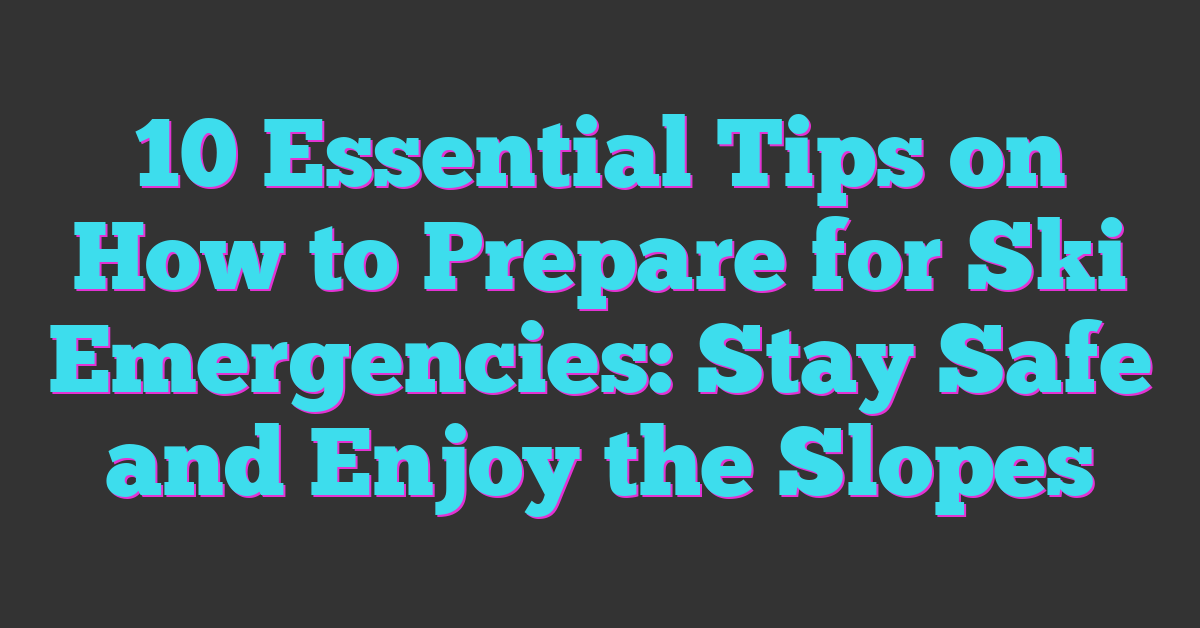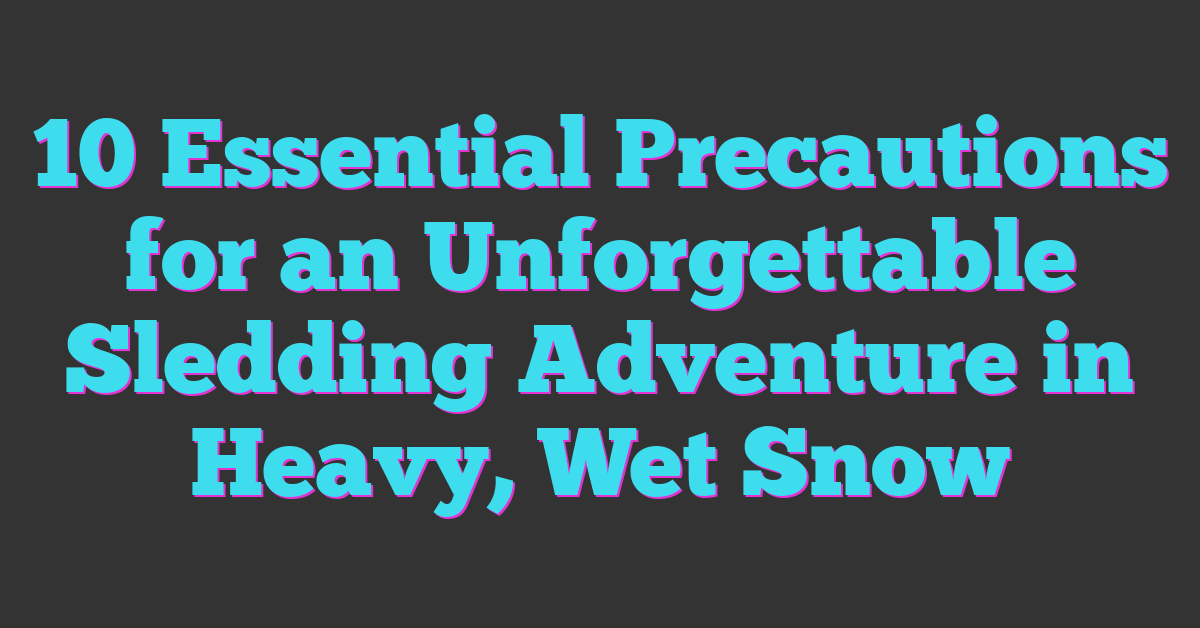Skiing is one of my favorite winter activities, but it comes with its own set of risks. Whether you’re gliding down the slopes or tackling a challenging run, being prepared for emergencies can make all the difference. The thrill of the mountain should never overshadow your safety, and knowing how to handle unexpected situations is crucial.

Understanding Ski Emergencies
Skiing brings excitement but also potential hazards. Awareness of ski emergencies helps maintain safety on the slopes.
Common Types of Ski Emergencies
- Injuries: Injuries like fractures, sprains, and collisions often occur. Slipping or falling can lead to severe strains.
- Hypothermia: Prolonged exposure to cold can cause hypothermia. Symptoms include shivering, confusion, and exhaustion.
- Avalanches: Avalanches present a significant risk in backcountry skiing. They can bury skiers under heavy snow.
- Equipment Failure: Binding malfunctions or ski breakage can leave me stranded or at risk. Checking gear before skiing ensures functionality.
- Lost or Disoriented: Losing the trail or getting disoriented can happen quickly. Familiarizing myself with the area and using a map helps prevent this.
Signs of Distress on the Slopes
- Excessive Fatigue: If I feel overly tired, it’s time to take a break. Fatigue increases the risk of accidents.
- Disorientation: Confusion about direction can indicate distress. Stopping and reassessing the surroundings clarifies my path.
- Visible Injuries: If I see another skier with visible injuries or struggling, approaching cautiously can help.
- Unusual Behavior: A skier acting erratically may indicate a problem. Staying close and offering assistance can make a difference.
- Signs of Cold Stress: Shivering, lack of coordination, or slurred speech signals cold stress. Seeking warmth and assistance immediately helps address this.
Understanding these emergency types and signs keeps me and fellow snow enthusiasts safe while enjoying our passion for winter sports.
Preparatory Steps
Preparation plays a vital role in ensuring safety during snow sports. It’s essential to assess personal skills and understanding the terrain before hitting the slopes.
Assessing Your Skills and Terrain
Assessing skills helps identify personal strengths and weaknesses. Beginners may struggle with balance and turning, while advanced skiers should focus on speed control and tackling challenging runs.
Assessing terrain is equally important. Familiar routes, marked trails, and understanding slope ratings—green for easy, blue for intermediate, black for difficult—help reduce risks. Evaluating weather conditions, potential hazards, and trail difficulty enhances decision-making, ensuring that I choose runs that match my skills.
Acquiring Necessary Gear
Acquiring the right gear is crucial for staying safe and comfortable. Invest in high-quality items like helmets, goggles, and base layers. Each piece of gear serves a distinct purpose:
- Helmets protect against head injuries.
- Goggles offer visibility and guard against harsh conditions.
- Base layers keep the body warm and dry.
I recommend carrying a well-packed backpack that includes essential equipment such as first aid kits, water bottles, and extra snacks. Having tools for minor repairs, like ski straps or multi-tools, ensures I’m ready for unexpected equipment malfunctions on the slopes.
Emergency Communication
Effective communication can make a significant difference in ski emergencies. Staying connected with fellow skiers and ski patrol ensures safety on the slopes.
Importance of Staying Connected
Staying connected is crucial during winter sports. Communication helps coordinate with friends and alert ski patrol in case of an emergency. It’s essential to share your location, especially in less crowded areas or when venturing off marked trails. I prioritize checking in regularly with my skiing buddies to confirm everyone’s well-being and location, which can be lifesaving if someone gets injured or lost.
Recommended Communication Devices
A few reliable communication devices enhance safety on the slopes.
- Mobile Phones: They provide quick access to emergency services and can help you stay in touch with your group. Ensure your phone is charged and consider using portable chargers for extended trips. Signal may be limited in remote areas, so don’t rely solely on this option.
- Two-way Radios: These devices allow immediate communication without needing cell service. Two-way radios work well when skiing in larger groups or on less trafficked terrain, ensuring constant contact.
- Personal Locator Beacons (PLBs): In backcountry areas, PLBs are vital for emergencies. They send out distress signals with GPS coordinates to rescue services when activated.
- Satellite Phones: For remote locations where cell coverage is sparse, satellite phones provide the best chance of staying connected. Though expensive, they offer peace of mind.
- Emergency Whistles: I always carry an emergency whistle. It’s lightweight and can be heard from considerable distances, making it effective for signaling help in emergencies.
Investing in these communication devices and knowing how to use them boosts safety and enhances the skiing experience, making my time on the slopes more enjoyable.
First Aid Basics
Being prepared with first aid knowledge enhances my snow sports experience. Emergencies can happen, but knowing the basics can make a significant difference.
Essential First Aid Kit Contents
Every snow sports enthusiast should pack a first aid kit. Essential items include:
- Adhesive bandages: Use them for minor cuts and scrapes.
- Sterile gauze pads: Apply to larger wounds to control bleeding.
- Medical tape: Secure gauze pads or splints.
- Antiseptic wipes: Clean injuries to prevent infection.
- Pain relievers: Carry ibuprofen or acetaminophen for pain management.
- Elastic bandage: Support sprains or strains effectively.
- Cold packs: Reduce swelling for injuries or overexertion.
- Thermometer: Monitor body temperature during emergencies.
- First aid manual: Reference for guidance on treating injuries.
Packing these items ensures preparedness for common injuries while skiing or snowboarding.
Recognizing and Responding to Injuries
Recognizing injuries early enhances safety on the slopes. Common ski-related injuries include:
- Fractures: Look for visible deformities or severe pain in the affected area.
- Sprains: Swelling or inability to move a joint indicates a possible sprain.
- Hypothermia: Watch for confusion, shivering, or slurred speech in fellow skiers.
Upon encountering an injury, assess the situation. If it’s a serious injury, immobilize the affected area and call for help. For less severe cases, provide first aid using items from the first aid kit, monitor the individual’s condition, and ensure they remain warm until help arrives. Quick response promotes better recovery and keeps everyone safe on the slopes.
Safety Protocols
Safety is vital on the slopes. I prioritize protocols that enhance my skiing experience while reducing risks.
Skiing with a Buddy System
Skiing with friends enhances safety. I always stick to the buddy system, ensuring I ski with at least one other person. This way, if accidents occur, help is available right away. I make a habit of agreeing on meeting points before tackling new trails and check in regularly to confirm everyone’s status. Having someone to share experiences with adds to the joy of snow sports while also providing an extra layer of safety.
Following Ski Resort Guidelines
Adhering to ski resort guidelines is crucial. I pay attention to signs, trail ratings, and rules specific to the area. These guidelines help prevent accidents and ensure everyone enjoys their time on the mountain. I stay within designated trails and understand the conditions of the slopes, especially after fresh snowfall or storms. Following the advice of ski patrol regarding weather conditions or avalanche risk is essential for a safe and enjoyable experience. Prioritizing these protocols keeps our adventures fun and secure.
Conclusion
Being prepared for ski emergencies is essential for every skier. It not only enhances our safety but also lets us enjoy the thrill of the slopes without unnecessary worry. I’ve learned that knowing how to respond to unexpected situations can make all the difference in ensuring a fun day on the mountain.
By prioritizing safety through preparation effective communication and first aid knowledge we can tackle the risks that come with skiing. Whether it’s checking in with friends or packing the right gear every little step counts. So let’s embrace our passion for skiing while keeping safety at the forefront. Happy skiing and stay safe out there!
















